Why £200 / $250 Is The 1080p Graphics Card Sweet Spot
The price of performance...
What's the best graphics card mere mortals can buy for around £200 / $250? This is a question for the ages. Or at least for a slow Thursday evening. In all seriousness, the £200 / $250 price point ticks a lot of important boxes. It's been in and around the sweet spot for balancing price and performance for properly gameable graphics for a while. I reckon it's also pretty near critical mass in terms of how much you lot are willing to spend on a video board. At a push, most of us can stretch to £200 / $250 if the payoff is great gaming. Luckily, it is.
As it happens, it wasn't all that long ago that AMD argued this price point was where its efforts would increasingly be focused. The inference at the launch of the Radeon HD 4870 back in 2008 was that anything more expensive amounted to little more than pixel-shaded point scoring for PR operatives. Not many people spent more.
Sadly, it turned out those sentiments were mere convenience. At the time, AMD didn't have a GPU to compete at the high end, so the £200 / $250 focus made for a plausible and punter-pleasing argument. As soon as AMD had a competitive high end chip again, guess what? It jumped straight back into the £300 - £500 market. It was ever thus.
But that was then. Right now, £200 / $250 lands you right in the meat of the gaming graphics market and with an awful lot of options. As ever, you'll have to start by grappling with a few classic trade-offs. You need to compromise on something.
You can have the very latest technology, for instance. Or a card with true high-end features like a really wide memory bus and a tonne of memory. What you can't have at this price point is everything. Then there's the whole AMD versus Nvidia thing, not to mention the question of matching your graphics card to the rest of your rig.
 AMD's Raeon R9 285 is nice for the price. But the 280X is a more bona fide high-end board...
AMD's Raeon R9 285 is nice for the price. But the 280X is a more bona fide high-end board...
I'm thinking here of things like CPU performance and monitor resolution. If you have a really feeble processor, money spent on graphics will basically be blown. Just how feeble need your CPU be to render a GPU upgrade redundant? On the Intel side, almost anything remotely recent with at least a couple of cores and decent 3GHz-plus clocks is pretty gameable and worth pairing with good graphics.
For AMD CPUs it's a little more complicated. For starters, my experience with AMD chips in-game has dwindled so much in recent years, I've lost that gut feel for what to expect. But if it's not at least four cores and probably 3.5GHz, I'd be worried about CPU bottlenecking, that's for sure.
As for the the monitor thing, you just need to bear in mind loads generated by different resolutions and the critical need to run modern LCD panels at native resolution for optimal image quality. 1080p (ie 1,920 by 1,080 pixels) is the most common resolution by a mile currently, and it's not actually all that demanding for modern GPUs.
In other words, if you're running 1080p with a slightly old graphics card and getting decent frame rates, maybe you don't actually need a new board. On the other hand, the step up to 1440p (2,560 by 1,440 pixels) is a biggie in terms of GPU load. You'll need something pretty snazzy in the graphics department if that's the direction you want to go.
Anywho, with those provisos in mind, what are your options?
For the 1080p-ers among you looking to keep costs down, you could do a lot worse than Nvidia's Geforce GTX 960. Instinctively, it's a GPU that makes me very uncomfortable with its pitiful 128-bit memory bus. But it does sport what you have to concede is the best graphics tech currently available, Nvidia's Maxwell architecture, and it knocks out great numbers at 1080p. Not bad for just £150 / $200 for a 2GB version. Just don't expect things to fly if you upgrade to 1440p. It's just not that kind of card.
 At $260 in the US, the AMD 290 is impossible to ignore.
At $260 in the US, the AMD 290 is impossible to ignore.
It's also worth noting that a 2GB frame buffer could become increasingly marginal, even at 1080p, with more demanding future titles. It's tricky to know just how much of a limitation that could prove.
The AMD alternative here is the Radeon R9 285 2GB. It's available here in the UK for sub-£130, which looks appealing. But US prices seem stuck up around GTX 960 levels / $200 for reasons I can't quite fathom. Still, it's another good 1080p card so long as you're not expecting epic future proofing. Oh, and it has a 256-bit memory bus. Decent.
The next step up involves a pair of distinctly elderly cards that somehow still remain relevant. I'm talking AMD Radeon R9 280X and Nvidia GeForce GTX 770. Availability on both is patchy, but I still prefer them to the newer alternatives (ie the AMD 285 or aforementioned Nvidia 960).
That's because both were once true high-end boards with features like big memory buses to match. For the Radeon, that means a full-on 384-bit bus and 3GB of memory for £200 / $250. Meaty.
 AMD factory coolers look like this. Avoid them.
AMD factory coolers look like this. Avoid them.
The GTX 770 is probably even harder to find. But it can be done, with 4GB variants available within our £200 / $250 remit. That's a lot of hardware for the money, even if it's old-school Nvidia Kepler clobber, not the latest Maxwell gubbins.
Both of these boards will do the business very, very nicely at 1080p but also make a pretty good stab at 1440p gaming, albeit with a few compromises on the eye candy required to get some games running really smoothly.
As a final twist, ponder this. Bump the budget to £250 / $300 and suddenly the likes of the AMD Radeon R9 290 and Nvidia Geforce GTX 970 enter the equation.
 Nvidia's 970 looks like value here in Blighty.
Nvidia's 970 looks like value here in Blighty.
Actually, in the US the 290 seems to go for as little as $260 while the 970 is more like $320. Such are the perils of trying to cover both sides of the Atlantic. Either way, what you're getting is a slightly cut-down version of each outfits' finest current GPU (well, bar Nvidia's new Titan X which is almost a category of its own). And that for me has always been the optimum.
Again, it's complicated by vagaries of pricing each side of the Atlantic. But $260 for an AMD 290 looks like a steal to me. In the UK, I'd lean towards an Nvidia 970 for about £250 simply because I continue to suffer significant driver-related headaches with AMD graphics. It's a cliché, but it's a cliché because it's actually true. AMD drivers remain more problematical.
As for what specific card to buy once you've chosen a chipset, I've never personally found it matters all that much. Occasionally something compelling appears. But of late that's chiefly been the compulsion to avoid the awful factory cooler on AMD cards. Fortunately, almost any AMD 290 or 280X you can buy today will have custom cooling. So, I'd say choose according to price, a supplier you are happy with and the warranty cover. Good luck.








